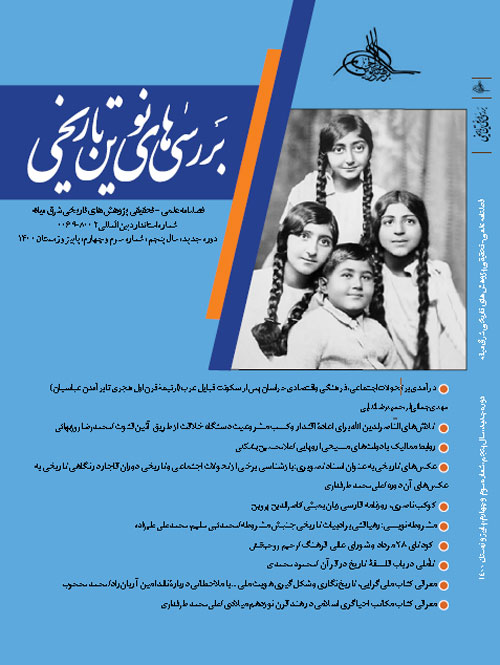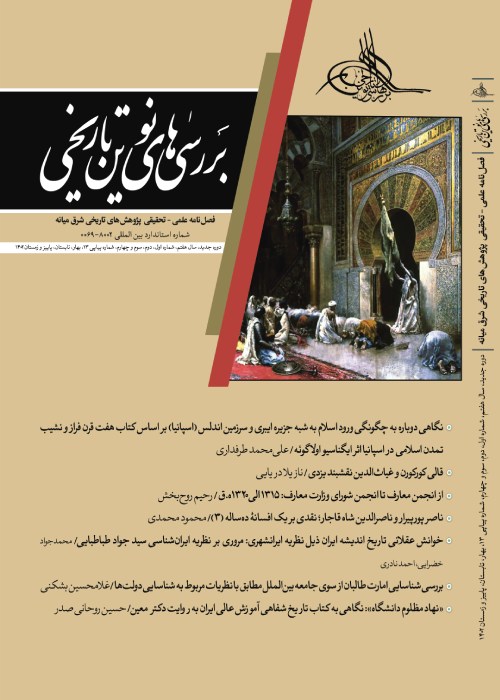فهرست مطالب

نشریه بررسی های نوین تاریخی
سال پنجم شماره 3 (پاییز و زمستان 1400)
- تاریخ انتشار: 1400/11/01
- تعداد عناوین: 11
-
صفحه 7
-
صفحه 125
-
صفحه 147
-
Page 9
The migration of various tribes and clans to Iran is one of the important issues in the history of this land. In the meantime, the migration of Muslim Arabs to Iran, which gradually shaped the religious identity of this land, is of great importance. Khorasan was the most important destination of Muslim Arabs in migration to Iran. In the first years of the Umaviyeh government, the first cohesive migration of groups of Arab tribes to Khorasan took place. The settlement of the Arabs in Khorasan and consequently the spread of Islam in it became the source of changes in the history of Khorasan in the beginning of Islam. The present article, with a descriptive-analytical approach, first describes the migration of Arabs to Khorasan and its extent, and then considers and examines the social, economic and cultural developments of the presence of Arabs in Khorasan. The spread of Islam, the prosperity of cities and the influence of Arabs and natives of Khorasan on each other’s culture were some of the most important consequences of the presence of Arabs in Khorasan.
Keywords: Arab tribes, Khorasan, Social developments, Cultural developments, Economic developments -
Page 31
One of the influential currents in the social life of the Iranian nation has been the ritual of Fotovvat, and many have tried to organize their personal and social behavior by entering the sect of the Fotovvat and following its instructions, thereby taking positive steps solving both social problems and self-cultivation. In this article, which has been written in a descriptive-analytical method, it is assumed that according to the time of Caliph Nasser al-Din Allah (622-575 AH), because of its simple solutions as well as relying on uncomplicated and common beliefs rooted in Sufism, the ritual of Fotovvat could be both a good tactic for increasing the authority of the caliph and gaining the legitimacy of the caliphate, as well as a factor for unifying the Islamic world. But the death of Al-Nasser and the failure to follow the next caliphs and, of course, the invasion of the Mongols prevented the creation of a special map of the ritual of Fotovvat in playing its special role in that historical period.
Keywords: Fotovvat, Legitimacy, Nasir al-Din Allah, Sufism, Abbasid Caliphate -
Page 41
Throughout the Islamic History until the establishment of the Uttoman Caliphate, the Mamluks was the first state which developed its diplomatic relations. Such development was fuelled by Commercial relations due to the Crusades, establishment of the Ilkhanid in Iran(East of the Islamic World) and the economic growth of the European nation-states including Venice,Geneva, Florence. Diplomatic relations wereaffected by the commercial ones. Due to its strategic situation and its vast realm, the Mamluk state managed to establish good political and economical relationships. Its Hostility to the Ilkhanids also pushed them to establish political relations with the Christian states of Europe. Meanwhile, the Mamluk political relations with the Christian states of Europe had its consequences in politics and the foreign relationships. One may more vividly understand the Mamluk’s foregin policy and its power relations through such political relationships. The study shows that in relation to the Christian states of Europe, the Mamluk always took their own interests into consideration. The Mamluk’s relations with the Christian states of Europe that was confined to the economic relations, to send the ambassador, to send letters emphasizing respect for the citizenship rights of the Christians and to open their church would end in hostile as well as friendly ties with them. Along with the foreign relationships and ambassador exchange, the commercial ties were on the way. The Mamluk’s Main goal to establish political relationships the Christian states of Europe is, first of all, to protect their national interests and to gain legitimacy against the Ilkhanid’s.
Keywords: The Mamluk, commercial relationships, the Christian states of Europe -
Page 59
The emergence of photography and filming industry during the Qajar era and documentation of many different developments of that period have provided researchers of contemporary history of Iran with many credible, genuine and coincident documents. So many untouched and lesser studied subjects are covered in the photographs or films which could be examined with diverse point of views and also fulfill the gap of evidence about certain historic events. For example, based on the photographs and documentaries of the Qajar era, the current researchers could infer certain innovative ideas in many subjects including: the clothing of Iranian ethnic groups, architecture and structural designs, the changes occurred in the condition of the historical monuments since Qajar time, details of certain important historic events such as Constitutional Revolution, the origins of some immigrant tribes to Iran, distinction in the social state of affairs since then and so on. In particular, the photographs and films are capable to represent the actual circumstances compared to the paintings and depictions of the artists; subsequently the researcher could employ the photographs and films of that period to re-evaluate the questionable historical issues or their details. In particular, regarding the subjects and structures which have changed so far, e.g. historical monuments, the significance of the primordial photographs and films are exceptional and unique to study the transformation of a monument or an archeological or historic site. In this paper, considering the variety of the mentioned topics and diversity of the photographic documents, I have intended to evaluate and represent novel historic outlook via observing certain important photographs of the Qajar period displaying much of aforementioned information.
Keywords: Historical photos, Qajar era, Social changes, Historical monuments -
Page 87
This article is about a newspaper published by the grandfather of Dr. Reza Sheikh al-Islami, a prominent professor at Oxford University, in Mumbai. The necessary references I have made to the content of the newspaper cannot contaminate the pure soul of that Iranian-loving man and his esteemed family. God bless him.
Keywords: Kokab Naseri, Persian Newspapers, Mumbai -
Page 99
Numerous articles have been written about the Iranian constitutional movement by internal and foreign writers. The diversity and multiplicity of views and judgments of these authors is one of the difficulties of studying and researching this political and cultural event in contemporary Iran. This article tries to challenge some of the misplaced approaches in the field of Persian historiographical literature by categorizing different groups of authors and criticizing their attitudes. It has been based on one-sided assessments and the lack of use of new methods of historical analysis, which still there is a vacancy of a solid and lasting research in this field.
Keywords: Historiographical literature, Constitutional movement, Writings andresearch, Authors’ attitudes -
Page 125
Following the new developments in Iran in the Qajar era, some areas were exposed to these developments faster than others. The educational system was one of them, which was crystallized in the form of new schools due to the need to provide manpower in other administrative, military and other fields. From the very first years of the formation of this system, the “Knowledge Association” was established in order to compile the laws and regulations required for schools, which later became known as the “High Council of Knowledge”, “High Council of Culture” and in recent decades has continued its activities as the “High Council of Education”. This council, like other government organizations, including legislative bodies, has been influenced by the country’s political condition. These effects have been more intense in some important situations such as the fall of Reza Shah, the coup of 28 Mordad, the Islamic Revolution, etc. This article is of a library type and has been written in a descriptive-analytical way. It indicates that the coup of August Mordad, 1332, deprived the council of its independence and turned it into an orderly institution. This article shows the change in the nature and direction of the activities of the High Council for the first time, citing the text of the minutes of the High Council of Culture.
Keywords: The coup of 28 Mordad, Educational system, Association of Knowledge, High Council of Knowledge, High Council of Culture -
Page 147
In his study, the author noticed a misunderstanding of the Qur’an’s expressions about the theoretical philosophy of history and decided to explain the philosophy of history from the perspective of the Qur’an. In this article, after extracting the components of different philosophies of history, an attempt has been made to show which of the theories of the Qur’an’s statements about the philosophy of history is more in line with the course of history. Finally, it turns out that according to the Qur’an, contrary to popular belief, the philosophy of history has a repetitive process and is not linear. This view is more similar to modern periodic philosophies.
Keywords: Quran, Philosophy of history, Divine prophets


